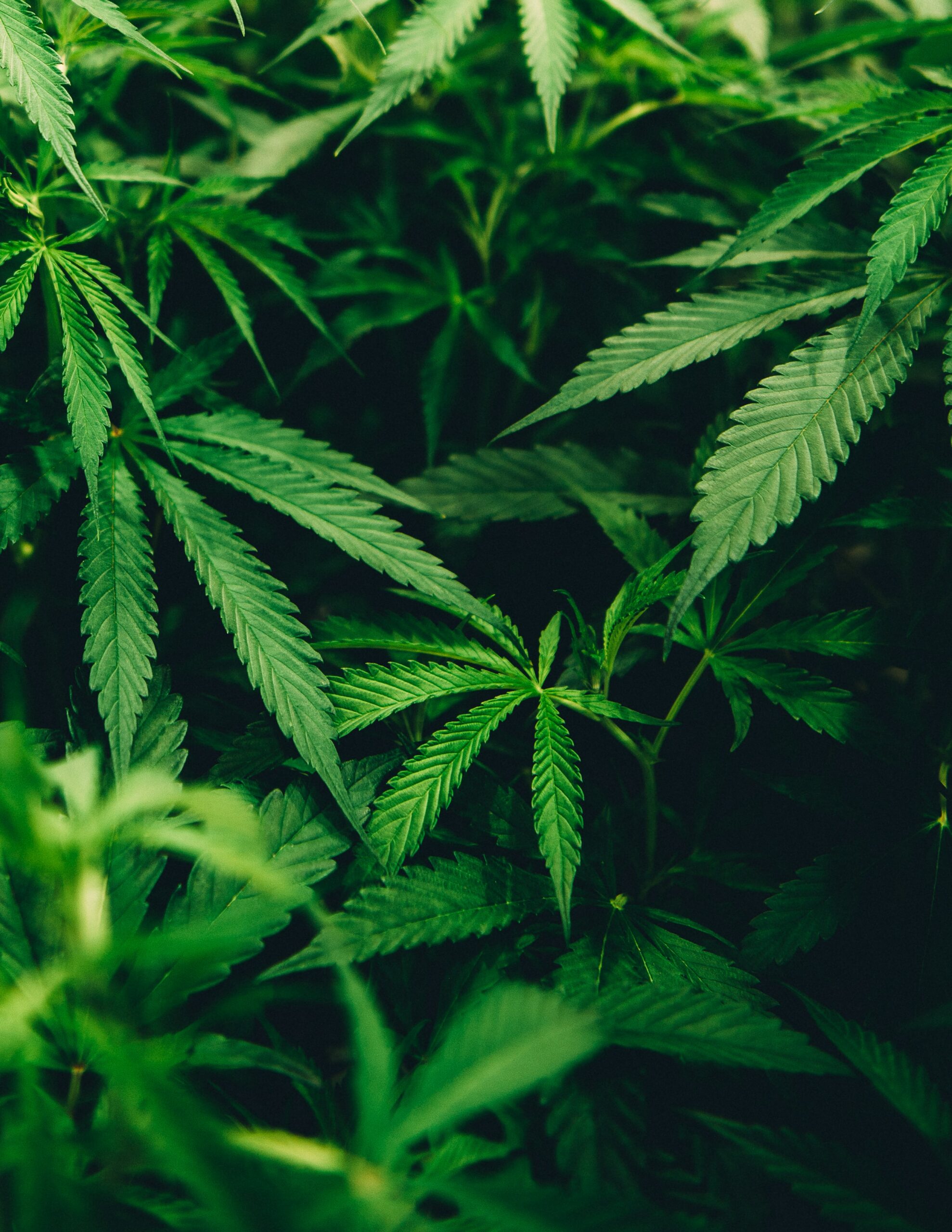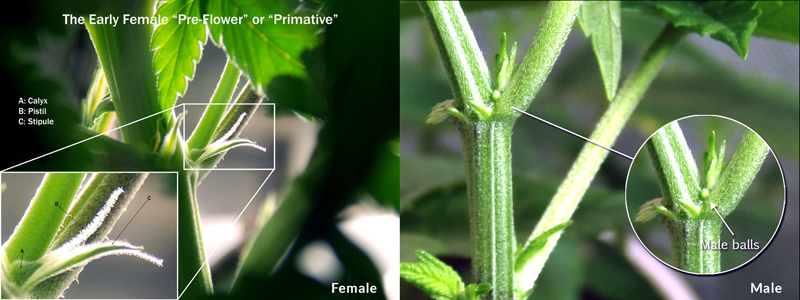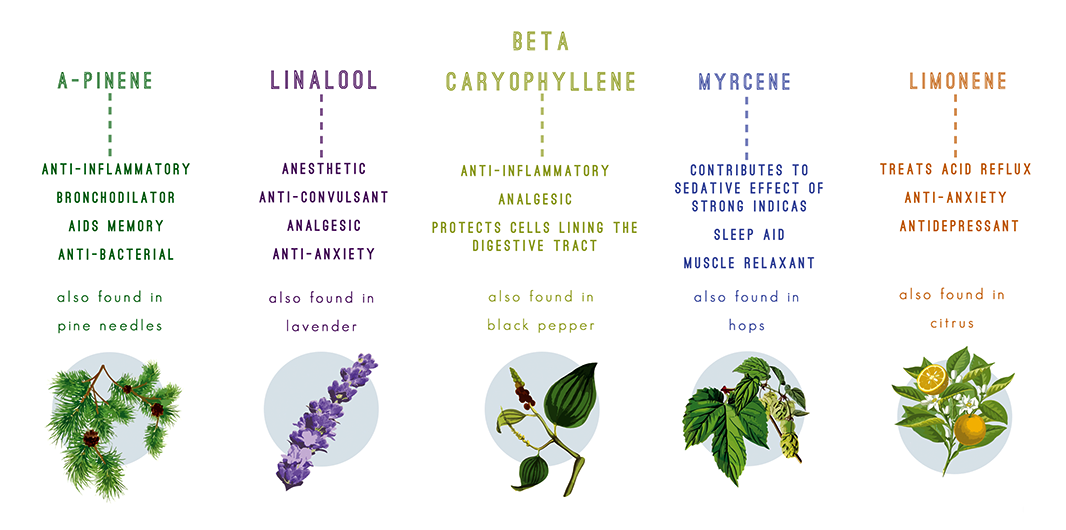Understanding the Anatomy of the Cannabis Plant
The cannabis plant (Cannabis sativa) contains many different compounds called phytocannabinoids that may have therapeutic properties.
Phytocannabinoids plant-based compounds found in cannabis
When talking about medicinal cannabis and its effect on health, the most familiar phytocannabinoids are THC (delta-9-tetrahydrocannabinol) and CBD (cannabidiol). There are many other compounds in cannabis that may be involved but are less understood.
Medicinal cannabis products are described by the amount of THC and CBD they contain.
THC can have both medicinal and psychoactive effects on the body CBD has medicinal but no psychoactive effects on the body.

What is Cannabis – The Anatomy of Cannabis Explained
Cannabis plants can be male, female or both (hermaphrodite). Growers can ensure the sex of their cannabis plants by growing clones or the genetically identical clippings from a parent strain. Feminized seeds are also made available through a special breeding process.
Female Cannabis Plants
- Female plants produce large resin- secreting flowers
- They are trimmed down to round or pointed buds.
- Sinsemilla – Potent flowers we consume come from seedless female plants.
- Produces large cannabinoid-rich buds, even without seed.
Male Cannabis Plants
- Males produce smaller spheres near the base of the leaves.
- The male plants pollinate the females to initiate seed production
Hermaphroditic Plants
- Hermaphroditic plants are rare
- Hermaphrodite cannabis plants contain both female and male sex organs
- This allows the plant to pollinate itself during flowering.
- This self-pollination typically spoils the seedless sinsemilla plants and passes on hermaphroditic genes.
The cannabis plant grows by cell division. Cells make clones of themselves and then proceed to expand in size. The division of these cells occurs rapidly at the top of the cannabis plant. This also applies to the root tips and in the upper part of the side shoots. The division of cells in these areas are continuous and speedy. Newly cloned cells elongate by absorbing water.
The Cannabis Leaf and Photosynthesis
Leaf cells are essential in the role of photosynthesis. The miracle of photosynthesis is such that the cannabis leaves can use light energy, combined with C02 and water to produce sugars (plant food).
To breathe in C02, the cannabis leaves must open microscopic pores located on their underside called “Stomata”. For 1 square inch of the cannabis leaf underside, there may be up to 50,000 stomata. As water is brought up the plant from the roots, the sugary plant food is then sent down for storage. Additional water then leads to more nutrient availability, increasing the plant growth.
Variances in the leaf colour indicate to growers whether there are mineral deficiencies within the plant. Since leaves are unable to repair themselves, they serve as a solid indicator of the plant health.
Photosynthesis is a fascinating look into the sophistication of plant growth and its survival. Specialised cells within the leaves called “pigments” perform within this process by absorbing a particular frequency of the light spectrum. It can extract energy by converting the photons to electrons. Most well known “pigments” include Chlorophyll A and Chlorophyll B. Beta-carotene, phytochrome and phycobilin are also very important.
Pruning the Cannabis Plant
The pruning process removes dead and discoloured leaves from the plant. This is necessary to promote the further production of energy. This process should be kept to a safe daily minimum so that the plant does not suffer shock.
Species
Cannabis Satvia
The use of Cannabis sativa (cannabis) extracts as medicine has been well documented historically throughout China and India with dates of usage as early as 6000BC. The therapeutic use of cannabis was introduced into Western medicine within the first half of the 19th century. It reached a peak period in the last two decades of this same century it was introduced. By the turn of the century, pharmaceutical companies were already marketing cannabis extracts and tinctures.
Medical practitioners prescribed Cannabis Sativa for a wide variety of complaints such as whooping cough, asthma, pain relief and as a sedative.
Around the middle of the 20th century, Medicinal Cannabis was close to disappearing completely. Reasons for this were the variable potency of cannabis extracts, as well as the introduction of synthetic pharmaceutical substitutes such as aspirin, and barbiturates. Legal restrictions were created prohibiting the use of cannabis-derived medicines.
In the 1960’s, the main active psychotropic constituent of cannabis, D9-tetrahydrocannabinol (D9-THC), was identified and synthesised. It took another 30 years to pass before clinical studies discovered the existence of the Endocannabinoid System and the receptors located in the human brain. The functionality of the Endocannabinoid System was then discovered which created an increased interest in Cannabis as a medicine. The legal status and regulations have since then been challenged and changed in a number of countries around the world. Scientific research across the globe has been testing the functionality of this system alongside the unique qualities of cannabinoids to heal and relief symptoms of disease and degeneration.
The term “Cannabinoid” describes the constituents of medicinal value within the cannabis plant, THC is an example of one. Cannabidiol, or CBD is another “Cannabinoid” which can constitute up to 40% of cannabis extracts and is non psychoactive. It has been found to be very effective in a number of medicinal treatments to which other pharmaceuticals perform poorly or result in unnecessary side effects.
A taller and thinner plant than that of the Indica strains, the Pure Sativa plant can reach up to 4.5 meters in height. It exhibits long internodes and branches which the leaves being of a lighter shade of green.
The Origin of the Sativa strains began in Columbia, Mexico, Thailand, and South East Asia.
Once the Sativa plant begins to flower, you can expect it to take anywhere from ten to sixteen weeks for full maturity. As vegetation periods are so long, these plants will typically produce a much higher yield than the Indica strains. The Sativa commonly possesses a lower THC percentage than Indica on average (around 12-16%).
Cannabis Indica
Cannabis Indica plants are short and wide in composure (2-4 feet tall) Cannabis Indica strains are typically darker green than sativa and have short, fat leaves.
The pure cannabis indica plants are believed to have originated in the Middle East such as in Pakistan, Afghanistan & Tibet. They are known to thrive when grown and cultivated in cooler environments.
Cannabis Indica strains typically have more chlorophyll than Sativa, thus they are known to grow and mature faster. Cannabis Indica typically yield smaller but higher quality crops with the percentage of THC up to 18% more than when cultivated from the Sativa plant.
As the plants grow fairly short they are the ideal for indoor growing. You can identify the buds by their thickness and density, flowering within eight to twelve weeks. After flowering starts the plants will be mature in 6 to 8 weeks. Typical of the Cannabis Indica variety are the potent aromas ranging from pungent skunk and sweet and fruity flavours and aromas.
Hybrids
Indica and Sativa are the two main varieties of the cannabis plant utilised for their medicinal value. Many strains are crosses of those two varieties. Within each of those varieties and crosses are another huge number of individual strains.
When you combine different Indicas, different Sativas or a combination thereof, it is considered a hybrid. The resulting hybrid strains will grow, mature and deliver their medicinal components based on the relativity percentages they end up containing.
Hybridization has many benefits to the breeder. They can attempt to create a breed that can fit exact specifications required by the end user. In today’s market, the hybrids dominate the market, as most strains have been crossed with each other previously.
These are Sativas that have been worked on by a breeder to fit within a special criteria. This criteria could be specific to the smell or taste of a Sativa. Often these hybrids contain some Indica genetics but appear mostly Sativa in nature.
In terms of medicinal value these are the best hybrids and they are most widely appreciated. Today’s “Kush” strains are a perfect example of these types and are easily the most popular. They tend to have qualities that both grower and patient find highly desirable. The majority of medical cannabis is hybrid Indica.
Cannabis Ruderalis
Cannabis Ruderalis is considered a subspecies of Cannabis Sativa that starts flowering regardless of the photoperiod. The name “Ruderalis” comes from the German word “ruderal”, a term used for weeds growing by the roadside.
Ruderalis is considered a subspecies of Cannabis sativa. There is a discussion that Cannabis Ruderalis may have evolved from cannabis indica plants that migrated further and further north. It is proposed that to survive, these plants had to start flowering much sooner. Thus, their traits evolved for environmental survival. Over the course of numerous generations, the Ruderalis species bloomed even earlier than they had historically. At some point, there was an emergence of a new generation of plants that flowered well before the others, regardless of the photoperiod. They were the first auto flowering plants.
To most people, this strange subspecies of the cannabis plant must have seemed utterly useless because of its difference in traits. Early Dutch breeders spoke about their concerns when the plants surfaced in the home growing scene. It could not be grown with good results indoors due to the photoperiod, flowering automatically within a month after it emerges from the soil. Though it is not ideal structurally and produces very small harvests of low potency bud, growers find there is far better cultivation when using Cannabis sativa and Indica.
There are many different varieties of commercial hemp, but too few of these strains are based on wild ruderalis. FIN-314, or Finola, is an auto flowering hemp strain created in 1995 for commercial crop growing in Finland. Its THC concentration is limited to a level acceptable to the government. Although these plants contain very little THC, they are rich in CBD and have medicinal uses that correspond to the CBD cannabinoid. Russian ruderalis has also been successfully transformed into industrial hemp strains grown for fibre, seed and oil.
When the Russian cannabis plants escaped from cultivation and beyond the reach of human hands, they began to lose the traits that they were selectively bred for. A new set of traits that were suitable for survival in the wild began to emerge. Ruderalis plants are slightly smaller than their sativa and indica counterparts, perhaps because they have less time to grow before they begin flowering. Cannabis ruderalis is similar to cannabis sativa in appearance, as the leaves are narrow. The plants are relatively short but lanky with a limited number of nodes and bud structures are sparse and infrequent.
This somewhat peculiar form of cannabis is known to have stemmed from cannabis sativa plants that escaped from outdoor plantations in Russia. Today ruderalis plants can be found in large populations all over central and Eastern Europe and Russia and grown in the wild. It is accustomed to the cold weather.
Ruderalis plants contain lower percentages of THC, but frequently they are cross-bred with Sativa strains. This produces plants that grow short like Ruderalis are known to grow like, however they can handle the weather outdoor where Sativa strains don’t usually flourish. These hybrids are known as auto-flowering strains, as the flowering period is short (2-3 weeks after germination). The strains have more resistance to insect infestation and are believed to have high CBD content. The whole life span of these plants though, can be as short as 7 weeks.
Trichomes
Greek – ‘Growth of Hair’.
Trichomes are the sticky resinous growths which are home to the active medicinal ingredients in cannabis.
There are 3 main types of trichomes on a cannabis plant.
Bulbous
- The smallest of the three coming in at 15-30 micrometers
- The head cells secrete a resin alongside an accumulation of related compounds
- When the gland matures, a protrusion may form from the pressure of accumulating resin.
Capitate-Sessile
- Larger in size, measuring approx 25 to 100 micrometers
- More numerous in count
- Globular-shaped head
- The head typically has 8 – 16 cells, that form a convex rosette which secrete cannabinoids and related compounds
Capitate Stalked
- There are an abundance of Cannabinoids in the capitate-stalked glands
- During flowering, the capitate glands that appear on the newly formed plant parts take on a third form. Some of the glands are raised to a height of 150 to 500 micrometres when their stalks elongate.
- These glands appear during flowering forming their densest cover on the female flower bracts
- High concentrations are also on the small leaves that accompany the flowers.
- The male flowers have some stalked glands, but they are smaller and less concentrated than on the female.
The evolution of trichomes suggests that they evolved as a defense mechanism of the cannabis plant. To ward away a wide range of potential enemies. It is suggested that this ‘Growth of Hair’ as indicated by definition acts as an evolutionary shield. Its purpose., to protect the plant and its seeds from environmental danger, thereby allowing it to reproduce.
The trichomes are sticky and their sprouts form a protective layering that prevents offensive insects from reaching the surface of the plant. The chemicals within the trichomes also make the cannabis undesirable for hungry animals to devour. The resin helps to insulate the plant from weathers containing high winds and low humidity. Additionally it creates a natural ‘sun-screen’ that protects the plant against UV-B rays.
Historically man has used the cannabis plant for its medicinal properties. The euphoric properties too have coveted its influence with growers favouring strains with higher THC concentrations. The trichomes house much more than just THC, come to find out years later. Not only do the trichomes house all the medicinally available cannabinoids of the plant, but comes the discovery our human physiology and the existence of our very own ‘in-house’ Endocannabinoid System. Equipped with receptors specific to Cannabinoid messages of healing and relief, the Cannabis Plant deserves further study, resourcing to the ill and respect as a medicine.
Terpenes provide the single largest array of varied tastes and odours available to a single class of chemical compounds. Terpenes make up the majority of components in flavouring agents found in food, candy and perfume. Obviously, the intensity of research has been well documented in these industries.
Limonene can create different odours from the original three, though this is dependent on the ratio and amounts used. More than any other industry, the perfume industry is well versed in these facts and has researched and documented similarities and differences between terpenes.
Each terpene has many medical benefits which give rise to overlapping synergies between them. Herbalists are well aware of this. By deliberately overlapping these benefits treatment has a much better chance at success.
How plants use terpenes
Plants use terpenes in several ways. Individual fragrant terpenes attract bees and other animals that carry the plant’s pollen to other plants; this is not the case for cannabis since its pollen is carried in the wind. Other terpenes are utilised defensively, either as an irritating warning to drive away herbivores that would eat the plant, or to attract predators of the herbivore. After hundreds of millions of years of evolutionary refinement of terpenes in plants, it’s no wonder that humans are so strongly attracted to some terpenes and repulsed by others.
Citronellol is a monoterpenoid found in roses, commonly used as a concentrated oil in perfumes.
The medicinal value of Phytol
Phytol is another interesting terpene, different from most others, offering yet other medicinal options to a patient. Phytol is one of the breakdown products of decomposed chlorophyll. Its aroma is floral and balsamic in nature. It is an immunosuppressant and impedes the activity of Aflatoxin (a mycotoxin) in the body. It is used as a topical to reduce itching (thereby reducing the urge to scratch) and to treat slow-healing tissue wounds. Phytol is a non-toxic yellow pigment suitable for dying foodstuffs.
Terpenes are utilised in many commercial products that we come into contact with daily such the fragrances in the air, cosmetics (as solvents and scents), medicine, candy, breakfast cereal and even in air fresheners. Their anti-bacterial/fungal abilities are used as preservatives and stabilisers.
Terpenes
Terpenes are responsible for some benefits we often fail to notice within consumable products. These benefits include the aromas or flavours in beer, sweets, perfume, fruit, incense and much more. Terpenes also offer a diverse array of medicinal and nutritional aspects.
Making up one of the largest family of chemical compounds, herbalists and apothecaries alike use terpenes in compounding remedies and medicine.
Isoprene is a five carbon long molecule that is the basis of all terpenes. Think of each five carbon isoprene as a single chain link. Terpenes are constructed of these chain links, such that most terpenes are 5, 10, 15, up to 40 carbons long. Limonene and Linalool are both ten carbons long, or contain two isoprene chain links, whereas Phytol, being a larger more oily molecule, contains 20 carbons or 4 isoprene links.
Any given terpene can be found to exist in an incredible variety of different plants. For instance, ß-Caryophyllene is found in black pepper, cloves, some cannabis Sativa strains, rosemary and hops.
Cannabinoids were initially believed to only exist in family Cannabaceae, but have since been found in other families of plants such as family Linaceae (Flax), and Asteraceae (Echinacea and Helichrysum). Not surprisingly, the heated/vapourised smoke of cannabis contains up to 50% terpenes, with cannabinoids accounting for 10-20% and the other terpenes accounting for another 10-30%.
In most cases, the larger the terpene molecule, the more viscous and less vaporous it is. Limonene evaporates very quickly, with a pungent fragrance: similar to acetone. Cannabinoids, on the other hand, are much larger molecules, are nearly solid at room temperature and have only a faint odour: similar to pine pitch. The size and structure of the terpene also determine factors such as how soluble it is in water, ethyl alcohol, oil, or other solvents, how easily it decomposes from heat, light and air, along with many other factors.
Myrcene is the most commonly found terpene in cannabis.
Myrcene is also found often in the highest concentrations. Myrcene is found in large amounts in hops, aged mango, bay leaves, and lemongrass. The odour varies but is described to have an herbal, balsamic, rooty, and spicy aroma. Its medicinal properties are well known, particularly used to treat pain and inflammation. Myrcene is known to have a calming effect both mentally and physically, which is why it has been used to treat psychosis and muscle spasms. The properties it encompasses has synergistic effects with other terpenes, like THC for pain, THC-A for inflammation, CBD and Linalool as an antipsychotic. Myrcene, THC, THC-A and CBD together treat muscle spasms.
Citronellol is a monoterpenoid found in roses, commonly used as a concentrated oil in perfumes.
The second most abundant terpene in cannabis are the Limonenes
Limonenes are terpenes found in the peel of citrus fruit, as well as in other fruits and flowers. Wearing a sweet, fresh fruity odour: the citrus aroma is unmistakable. Limonenes carry benefits including antidepressant, anxiety-relief, immuno-stimulant (similar to garlic), antitumour, and bacterial / anti-fungal properties. Limonenes aid in treating gastric reflux and treat oesophagal ulcers.
Limonenes can be used topically as an antiseptic agent and are quite effective to repel insects: the leaves of the lemon or grapefruit tree are used for this purpose. Limonenes have synergies with THC-A, CBD-A, CBC-A, CBC, CBC, CBG, Caryophyllene-Oxide, and Linalool.






